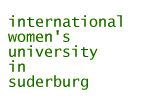
 |
workshop |
|
This workshop for ifu students dealt with the project area's topic 'water' in an unconventional manner: combining aesthetical and practical artistic approaches, working with a group of scientists. It's aim was to develop an idea of the cultural dimension of water, starting from the participants expertise of scientific research techniques. This application of a combination of scientific as well as artistic approaches towards the topic enabled the students to gain surprisingly new insights into the project area from an inter-disciplinary perspective. On two weekends, students from India, Korea, Vietnam, Indonesia, Ethiopia, Thailand and Germany participated in the project which was organized by Claudia Jonischkies and the tutors Dr. Namrata Pathak from India and Sermsook Pakkattang from Thailand. During the workshop, students investigated rivers, creeks and small lakes in the surroundings of Suderburg, took water samples, discovered this usually invisible world hidden to the naked eye, and finally took photos in order to document the results. In parallel to the documentation of photographic representations of water, the group worked on an installation that displayed water in its very own materiality. |
 |
 |
 |
 |
 |
 |
 |
|
The group presented the workshop's results in an exhibition at the FH in Suderburg: An installation consisting of 40 bags filled with water samples, water plants, little stones and sand taken from the different lakes etc. Each bag in itself a small world of its own, representing the area it was taken from: Sand and stones in layers at the bottom, small musty parts of plants floating in the water, and finally, little water plants on the water's surface. Next to the installation, an assemblage of 200 photos. The strongly enlarged images of water's microorganisms revealed a hidden universe of underwater life, a microcosmos with specific aesthetics of colors and shapes. |
 |
 |
 |
 |
 |
 |
| Click on small image to enlarge. | |||||
|
It is another world of colors and shapes visualized in this series of photos. A strange world that we are excluded from in every day life, not visible to our naked eyes, approachable at most for a scientific interest, in order to analyze and categorize it. The workshop's main focus was on the use of innovative approaches to an experimenting kind of aesthetic analysis of nature and the environment, based on a fundament of aesthetic and practical methods. It's aim was to create awareness for the interrelations of humans, nature, and the environment through practical work. Doing so, the workshop was able to obtain new ideas regarding environmental communications: new insights into the relationship of humans and nature, nature and the environment, and consequently, new approaches for a better, more differentiated understanding of nature and the environment. The workshop's practical work visualized cultural patterns and structures of the way we experience, think and act, and subsequently communicated these insights in different ways and on different levels. The complex task trained capabilities of creative and flexible strategies of problem solving and developed the communicative aspect, enhanced the student's personal capabilities in non verbal communication:communicate and document complex concepts and ideas, visualize these ideas with different media, present results of the working process. In addition to cognitive problem solving methods, the students also cultivated the potential of an active aesthetic-practical way of approaching, understanding and solving complex tasks. Artistic processes, a conjunction of intuition and reflection, artistic creativity as intuitive intelligence. This "artistic" method of perceiving, understanding and acting was particularly made available to students without an artist background. Thus the workshop provided these students of technology and natural sciences another dimension of active communication. The concept approached the complexity of its subject from inter-disciplinary and multi-dimensional positions, combining ideas and concepts from different institutional areas of science, art and knowledge: Making use of the potential of active aesthetic approaches and insights, enhancing sight in exchange with other disciplines within a multidimensional cooperation of different areas of scientific and cultural strategies. The complementary use of different methods created complex perspectives of understanding and acting. By using an artistic approach towards scientific topics, the work shop revealed new ways of understanding - to the participants, as well as the visitors of the exhibition: New ways of understanding the inter-relationship of humans, nature and environment, as well as innovative strategies for the presentation of research results. (text by Claudia Jonischkies) |